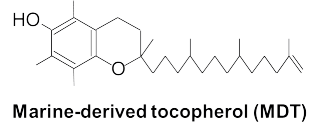
Back to Previous Page
5. Vitamin E
Details

Fig. 1 Structure of vitamin E homologues
The biological activity of vitamin E indicates the relative biological availabilities of vitamin E homologues in mammals. The relative biological availabilities of vitamin E homologues are thought to be strongly related to the affinity of the respective homologues for a-tocopherol transfer protein (a-TTP) in the liver. Representative values for the biological activities of vitamin E homologues are shown in Table 1. This table suggests that a-tocopherol has the highest biological activity and is the most-needed tocopherol in mammals from the range of vitamin E homologues.
| Vitamin E Homologues | Relative Biological Availability (Vitamin E Activity) |
| a-Tocoherol | 100 |
| b-Tocopherol | 2-40 |
| g-Tocopherol | 1-11 |
| d-Tocopherol | 1 |
| a-Tocotorienol | 27-29 |
| b-Tocotrienol | 5 |
Recently, however, a novel type of vitamin E has been discovered in salmon roe. This form of vitamin E was named as “marine-derived tocopherol” (MDT) (Fig. 2). The structure of MDT resemblesa-tocopherol, with the exception of the presence of 1 double bond at the terminal end of the phytyl side chain. This tocopherol is distributed in a wide range of marine organisms. Our group confirmed that MDT is also present in processed foods made from fish meat.
(N. Gotoh, D. Mashimo, T. Oka, K. Sekiguchi, M. Tange, H. Watanabe, N. Noguchi, and S. Wada, Analyses of marine-derived tocopherol in processed foods containing fish. Food Chem. 129,279-283 (2011). [Abstract])

Fig. 2 Structure of MDT
We also examined the relative biological availability of MDT by using a mouse model. Our results show that the relative biological availability of MDT is higher than that of b-tocopherol (Table 2).
Table 2 Relative biological availabilities of MDT
| Vitamin E Homologues | Relative Biological Availability (Vitamin E Activity) |
| a-Tocoherol | 100 |
| b-Tocopherol | 26 |
| g-Tocopherol | 4 |
| d-Tocopherol | Not Detected |
| MDT | 49 |
(N. Gotoh, H. Watanabe, T. Oka, D. Mashimo, N. Noguchi, K. Hata, and S. Wada, Dietary marine-derived tocopherol has high biological availability in mice relative to alpha-tocopherol. Lipids 44, 133-143 (2009). [Abstract])